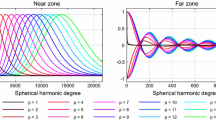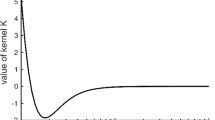Abstract
To reduce the numerical complexity of inverse solutions to large systems of discretised integral equations in gravimetric geoid/quasigeoid modelling, the surface domain of Green’s integrals is subdivided into the near-zone and far-zone integration sub-domains. The inversion is performed for the near zone using regional detailed gravity data. The farzone contributions to the gravity field quantities are estimated from an available global geopotential model using techniques for a spherical harmonic analysis of the gravity field. For computing the far-zone contributions by means of Green’s integrals, truncation coefficients are applied. Different forms of truncation coefficients have been derived depending on a type of integrals in solving various geodetic boundary-value problems. In this study, we utilise Molodensky’s truncation coefficients to Green’s integrals for computing the far-zone contributions to the disturbing potential, the gravity disturbance, and the gravity anomaly. We also demonstrate that Molodensky’s truncation coefficients can be uniformly applied to all types of Green’s integrals used in solving the boundaryvalue problems. The numerical example of the far-zone contributions to the gravity field quantities is given over the area of study which comprises the Canadian Rocky Mountains. The coefficients of a global geopotential model and a detailed digital terrain model are used as input data.
Similar content being viewed by others
References
Hagiwara Y., 1976. A new formula for evaluating the truncation error coefficient. Bulletin Geodesique, 50, 131–135, doi: 10.1007/BF02522312.
Heiskanen W.H. and Moritz H., 1967. Physical Geodesy. W.H. Freeman and Co., San Francisco.
Hirvonen R.A. and Moritz H., 1963. Practical Computation of Gravity at High Altitudes. Report 27, Inst. Geod. Photogram. and Cartogr., The Ohio State University, Columbus.
Hotine M., 1969. Mathematical Geodesy. U.S. Department of Commerce, Washington D.C.
Huang J., 2002. Computational Methods for the Discrete Downward Continuation of the Earth Gravity and Effects of Lateral Topographical Mass Density Variation on Gravity and the Geoid. Technical Report 216, Dept. of Geodesy and Geomatics Engineering, University of New Brunswick, Fredericton, Canada.
Lemoine F.G., Kenyon S.C., Factor J.K., Trimmer R.G., Pavlis N.K., Chinn D.S., Cox C.M., Klosko S.M., Luthcke S.B., Torrence M.H., Wang Y.M., Williamson R.G., Pavlis E.C., Rapp R.H. and Olson T.R., 1998. The Development of the Joint NASE GSFC and the National Imagery and Mapping Agency (NIMA) Geopotential Model EGM96. National Aeronautics and Space Administration, Goddard Space Flight Center, Greenbelt, Maryland, USA.
Martinec Z., 1996. Stability investigations of a discrete downward continuation problem for geoid determination in the Canadian Rocky Mountains. J. Geodesy, 70, 805–828.
Molodensky M.S., Yeremeev V.F. and Yurkina M.I, 1960. Methods for Study of the External Gravitational Field and Figure of the Earth. TRUDY Ts NIIGAiK, 131, Geodezizdat, Moscow (English translat.: Israel Program for Scientific Translation, Jerusalem 1962).
Novák P., 2003. Geoid determination using one-step integration. J. Geodesy, 77, 193–206.
Paul M., 1973. A method of evaluating the truncation error coefficients for geoidal heights. Bulletin Geodesique, 110, 413–425.
Prutkin I. and Klees R., 2008. On the non-uniqueness of local quasi-geoids computed from terrestrial gravity anomalies. J. Geodesy, 82, 147–156, doi: 10.1007/s00190-007-0161-1.
Tenzer R. and Novák P., 2008. Conditionality of inverse solutions to discretised integral equations in geoid modelling from local gravity data. Stud. Geophys. Geod., 52, 53–70.
Vaníček P. and Sjöberg L.E., 1991. Reformulation of Stokes’s theory for higher than second-degree reference field and a modification of integration kernels. J. Geoph. Res., 96(B4), 6529–6539.
Vaníček P., Najafi M., Martinec Z., Harrie L. and Sjöberg L.E., 1995. Higher-degree reference field in the generalised Stokes-Helmert scheme for geoid computation. J. Geodesy, 70, 176–182.
Witte L., 1967. Truncation errors in the vertical extension of gravity anomalies by Poisson’s integral theorem. Bulletin Geodesique, 83, 41–52.
Author information
Authors and Affiliations
Corresponding author
Rights and permissions
About this article
Cite this article
Tenzer, R., Novák, P., Prutkin, I. et al. Far-zone contributions to the gravity field quantities by means of Molodensky’s truncation coefficients. Stud Geophys Geod 53, 157–167 (2009). https://doi.org/10.1007/s11200-009-0010-1
Received:
Revised:
Accepted:
Published:
Issue Date:
DOI: https://doi.org/10.1007/s11200-009-0010-1




